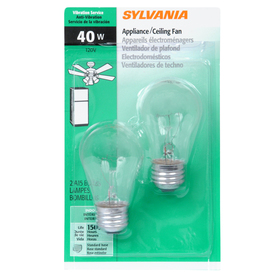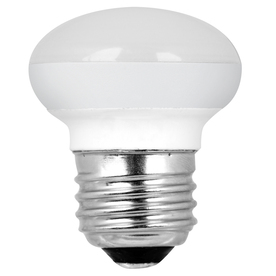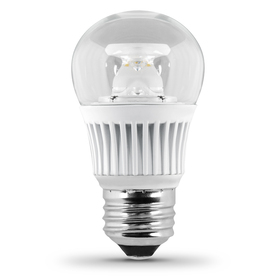Action is inspired by once again, the death of an incandescent bulb.
Bulbs loaded have been 40-watt appliance lights. Lowe's sells them, only $2.77 for a two-pack. But, I am done with this foolishness. I find one of these in my refrigerator, and I want it gone, too.
This bulb might be the solution, at a hefty price.
Utilitech 4.5-Watt (40W Equivalent) R14 Medium Base (E-26) Soft White Dimmable Indoor LED Spotlight Bulb
$14.98 at Lowe's. #0477033, UPC 17801 99201.
It is very nicely dimmable and silent in a dimmer circuit. It draws 6 watts for me, not the claimed 4.5 watts. I know I will be very unhappy with its 2700°K color temperature.
Utilitech #0477033 at left on my comparison stand. 40 watt appliance bulb at right. A 40 watt incandescent is B1.6, B4 times 40/100. I will guess by next observation that Utilitech #0477033 300 lumens LED, is B3. I think this photo shows times two brightness difference. The dinky little LED will be so much better, in a refrigerator.
Utilitech #0477033 at right on my comparison stand. 4" Glimpse 3000°K at left, defined B4 at 450 lumens.
Utilitech #0477033 is claimed 300 lumens and 4.5 watts. I measure 6 watts draw, and suspect lumens are not up correspondingly. This dinky light is not good LED technology, efficacy only fifty lumens per watt, and lumens not practically delivered in old light-bulb luminaires.
In the vanity bar, the Utilitech #0477033 is in fact horribly dim, very inferior to the 40 watt incandescent. Likewise in my refrigerator. At the vanity, not much above my face, the down directionality is adverse. In my refrigerator I need a bulb that illuminates downward in a side-facing socket. We will never see LED bulbs that overcome point-source wastefulness for sockets to-the-side, and this reveals the madness of holding on to residential lighting as point-source.
At left the dinky Utilitech #0477033, 2700°K, 6 watts, estimated B3.1 At right, Ecosmart 1001 370 396, 3000°K, 11 watts, estimated B3. Comparison for direst assessment of brightness is difficult where color temperature is not matched, but call the Utilitech #0177033 brighter.
In fact, room illumination with the little lights is unacceptable from a lowered light bar. One wants the wall illumination possible with ceiling-height lights of large beam angle.
In my vanity bar, try this Utilitech #0596936 at Lowe's, 3000°K. At claimed 60-watt equivalence, drawing actual 8 watts, claimed 7 watts/ 500 lumens, it will be too bright, and still eye-jarring.
At left Utilitech #0596936. At right, the 40 watt appliance bulb. Utilitech #0596936 claiming 60 watt equivalence is quite a bit brighter than the appliance bulb, as it should be, and draws 11 watts as measured with a Kill A Watt P3 meter. The appliance bulb does draw 40 watts. I could replace all four bulbs now with these bright Utilitech, at cost $50. They are silent on a dimmer, but even dimmed, the glare is unacceptable.
These bulbs from Home Depot, Ecosmart 1001 370 396, cost $19.97. They dim, but are far too noisy in a dimmer circuit. They draw 11 watts, not claimed 9 watts.
At left Utilitech #0596936. At right, Ecosmart 1001 370 396. The Ecosmart is even brighter than the Utilitech.
At left, FEIT Electric 60 Watt LED Bulb , UPC 17801 14325. At right, Ecosmart 1001 370 396. The FEIT bulb was found cheap at Home Depot, $11.97 for a six-pack. Silent on a dimmer. But, I can't find them now. An 11 watt power draw vs. again-claimed 9 watts makes the FEIT very like the Ecosmart. The FEIT is better on brightness, and a better choice all around.
I had sawn the very thick lens off that FEIT bulb. Knock it off again to assess the efficiency loss at the obscuring lens. So much illumination is sacrificed to make these bulbs look like incandescent, and bearable to our eyes.
Blinding glare, without the lens, and fully directional.
Surely half of the available light is lost at the lens, and the bulb becomes less directional.
4" Glimpse, 3000°K at left, without lens. At right, Ecosmart 1001 370 396. The revealed 450 lumens Glimpse is, of course, less bright than the the 800 lumens FEIT LED without its lens.
Lenses do waste light.
The Glimpse diode array is also very eye-jarring without the lens.
4" Glimpse, 3000°K at left, at 450 lumens defined B4. At right, Ecosmart 1001 370 396. The 800 lumens Ecosmart is perhaps B3, with very much waste.
At left, 60 watt GE Reveal incandescent, perhaps B4*60/100 = B2.4. At right, Ecosmart 1001 370 396, estimated B3.
A "60 watt" LED bulb is much brighter than an actual 60 watt incandescent.
At left, Sylvania BR30 LED, 2700°K, 650 lumens, B4*650/450 = B5.8. The BR30 is claimed 9 watts and is actual 11 watts. At right, Ecosmart 1001 370 396, estimated B3.
The relative efficiency of a BR30 LED, and an LED point-source bulb, with same power, by these observations, is 5.8/3, still the 2:1 natural advantage of downlight directionality.
Until I find a lighting solution in ceiling-mounted directional LED disks, accept the not-pretty luminaire but good light, of two 2700°K BR30 LED bulbs. 22 watts total by my measurement. Say this is 1300 lumens off-center illumination of about four square meters, 300 lux.
I expect that the same result may be achieved by placing many smaller LED downlights at ceiling height. If 450 lumens is too large a unit of light for dispersion of shadows, choose a smaller unit of light. The B2, 250 lumens of a 4" Conturrent™ LED Downlight , is interesting. Imagine a half dozen of these lights in a 100 sq ft bathroom ceiling. Three watts each, times six, is 18 watts, down from 160 watts, a reduction of almost 90% and with improved illumination. 6* 250 lumens/ 9.3 sq meters = 161 lumens per sq meter vs. maybe 300 needed, is dim unless concentrated at a vanity. Four of those BR30 overhead is extreme brightness, but for symmetry, I will try it.




















No comments:
Post a Comment